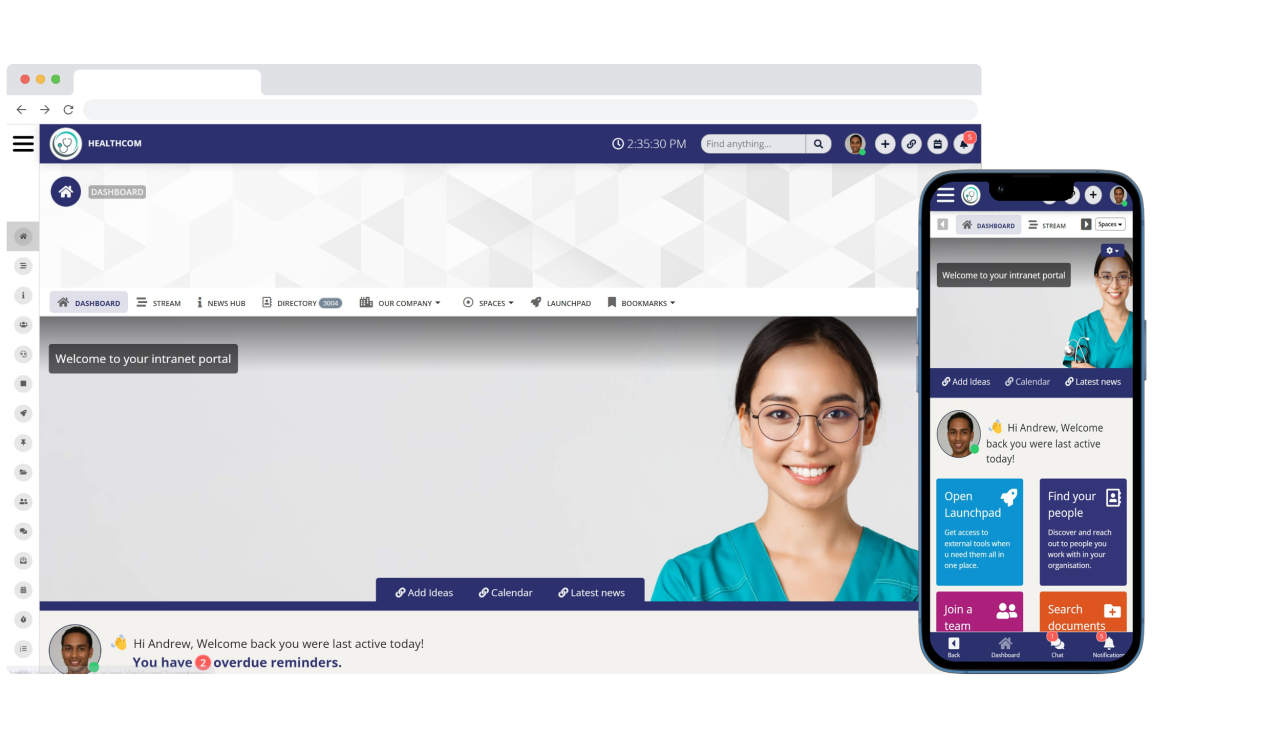Insight Blog
Agility’s perspectives on transforming the employee's experience throughout remote transformation using connected enterprise tools.
8 minutes reading time
(1541 words)
Intranet for schools
Intranet for schools or institution provides a secure and reliable platform to help meet the needs of the students. Read more about Intranet for schools.
As technology continues to evolve, schools are adapting to the changes by incorporating a digital learning environment. One key aspect of this is the use of an intranet, which is an internal network specifically designed for communication and collaboration. In this article, we will explore the importance of intranet for schools, the key features of an effective school intranet, and best practices for implementing one.
Intranet for education:Understanding the Importance of Intranet for Schools
Schools are complex organizations that require seamless communication and collaboration between teachers, students, and staff members. An intranet provides a secure and central platform for all stakeholders to access important information and resources.
Here are some ways intranet can help:
Enhancing Communication and Collaboration
With an intranet, teachers can communicate effectively with their colleagues and students can easily collaborate on group projects. Staff members can also share important announcements and updates, ensuring everyone is on the same page.
Effective communication and collaboration are essential to the success of any educational institution. With the help of an intranet, teachers can easily share lesson plans, discuss teaching strategies, and work together to create a more cohesive learning environment. Students can collaborate on group projects, share notes, and work together to achieve academic success.
Schools intranet can help staff members share important announcements and updates, ensuring everyone is informed and up-to-date with the latest news and events.
Streamlining Administrative Tasks
Schools intranet can simplify administrative tasks like managing student records, scheduling events, and submitting forms. This can save time and reduce errors, allowing staff members to focus on improving the academic experience for students.
Administrative tasks can be time-consuming and tedious, but they are essential to the smooth running of any educational institution. With the help of an intranet, staff members can streamline these tasks, saving time and reducing errors. Student records can be easily managed and updated, events can be scheduled with ease, and forms can be submitted online, eliminating the need for paper forms and reducing the risk of errors.
Encouraging a Digital Learning Environment
An intranet makes it easy to incorporate technology into the classroom by providing access to online resources and activities. This helps prepare students for the 21st-century workforce and keeps them engaged in their learning.
Technology is an essential part of modern education, and an intranet can help schools incorporate it into their curriculum. With access to online resources and activities, students can learn in a more engaging and interactive way. They can also develop important digital literacy skills that will be essential in the 21st-century workforce. Teachers can use technology to create more dynamic and interactive lesson plans, keeping students engaged and motivated to learn.
In conclusion, an intranet is an essential tool for any educational institution looking to enhance communication and collaboration, streamline administrative tasks, and encourage a digital learning environment. By providing a secure and central platform for all stakeholders to access important information and resources, an intranet can help schools achieve their academic goals and prepare students for success in the 21st-century workforce.
Key Features of an Effective School Intranet
While there are a variety of intranet solutions available, effective school intranets share some common features. In this article, we will explore these features in more detail to help you understand why they are important for creating a successful school intranet.
User-Friendly Interfacee
A well-designed intranet should be intuitive and easy to navigate for all users, regardless of their tech-savviness. This means that the interface should be clean and uncluttered, with clear labels and easy-to-use navigation menus.
One way to achieve a user-friendly interface is to conduct user testing during the design phase. This involves asking a group of representative users to test the intranet and provide feedback on its usability. Based on this feedback, designers can make adjustments to improve the interface and make it more user-friendly.
Customizable Design and Layout
An intranet that can be customized to reflect the school's branding and culture is more likely to be embraced by users. This means that the design and layout should be flexible enough to accommodate different color schemes, logos, and other branding elements.
Customization can also extend to the layout of the intranet.
For example, some schools may prefer a more visual layout with lots of images and videos, while others may prefer a more text-based layout with fewer visuals. By allowing for customization, the intranet can be tailored to the specific needs and preferences of the school.
Secure File Sharing and Storage
The ability to securely store and share files within the intranet is important for safeguarding sensitive information. This means that the intranet should have robust security features, such as encryption and access controls, to prevent unauthorized access to files.
One way to ensure secure file sharing and storage is to use a cloud-based intranet solution. Cloud-based solutions offer built-in security features and can be accessed from anywhere with an internet connection, making them ideal for schools with remote staff or students.
Integration with Learning Management Systems
An intranet that can be integrated with popular learning management systems like Moodle or Blackboard can simplify the process of managing course materials and assignments. This means that teachers can easily upload course materials and assignments to the intranet, and students can access them from a centralized location.
Integration with learning management systems can also help to improve communication between teachers and students.
For example, teachers can use the intranet to send announcements and messages to students, and students can use the intranet to ask questions and get feedback on their work.
Access Control and Permissions
A school intranet should have comprehensive access control and permissions settings that can be tailored to the needs of different users. This means that administrators should be able to control who has access to different parts of the intranet, and what they can do once they are there.
Access control and permissions can help to ensure that sensitive information is only accessible to authorized users. For example, teachers may have access to student records, but students should not have access to each other's records.
In conclusion, an effective school intranet should be user-friendly, customizable, secure, integrated with learning management systems, and have comprehensive access control and permissions settings. By incorporating these features into your school intranet, you can create a centralized hub for communication, collaboration, and information sharing that will benefit teachers, students, and administrators alike.
Implementing a School Intranet: Best Practices
Creating an effective school intranet requires careful planning and execution. Here are some best practices to follow:
Involving Stakeholders in the Planning Process
When planning an intranet for a school, it's important to involve all stakeholders in the process. This includes teachers, students, and staff members. By involving all stakeholders in the planning process, the intranet can be designed to meet their needs and preferences. This can help ensure that the intranet is used effectively and that it provides value to the entire school community.
During the planning process, it's important to gather feedback from all stakeholders. This feedback can be used to identify the most important features and functions for the intranet. It can also be used to identify any potential issues or concerns that need to be addressed.
Establishing Clear Goals and Objectives
Before implementing an intranet, it's important to establish clear goals and objectives. This helps ensure that everyone is working towards a common goal. The goals and objectives should be specific, measurable, achievable, relevant, and time-bound.
Examples of goals for a school intranet might include improving communication between teachers and students, providing a central location for important school information, and promoting collaboration among students and staff.
Providing Adequate Training and Support
Effective training and support are crucial for promoting user adoption and ensuring everyone is comfortable using the intranet. This is especially important for users who may not be as tech-savvy or who may be resistant to change.
Training and support can take many forms, such as online tutorials, in-person training sessions, and help desk support. It's important to provide ongoing training and support to ensure that users are able to fully utilize the intranet's features and functions.
Regularly Evaluating and Updating the Intranet
An intranet that's regularly evaluated and updated can continue to meet the evolving needs of the school community. This can help ensure that the intranet remains relevant and useful over time.
Regular evaluations can help identify areas for improvement and opportunities for new features and functions. Updates can be made based on user feedback, changes in technology, and evolving needs within the school community.
With the right planning and execution, an intranet can enhance communication, boost collaboration, and improve administrative efficiency in schools. By implementing best practices and assessing the needs of the community, schools can create an intranet that meets the needs of all stakeholders and contributes to an engaging digital learning environment.
Categories
Blog
(2600)
Business Management
(319)
Employee Engagement
(207)
Digital Transformation
(173)
Intranets
(119)
Growth
(118)
Remote Work
(61)
Sales
(48)
Collaboration
(37)
Culture
(29)
Project management
(29)
Customer Experience
(26)
Knowledge Management
(21)
Leadership
(20)
Comparisons
(5)
Ready to learn more? 👍
One platform to optimize, manage and track all of your teams. Your new digital workplace is a click away. 🚀
Free for 14 days, no credit card required.














